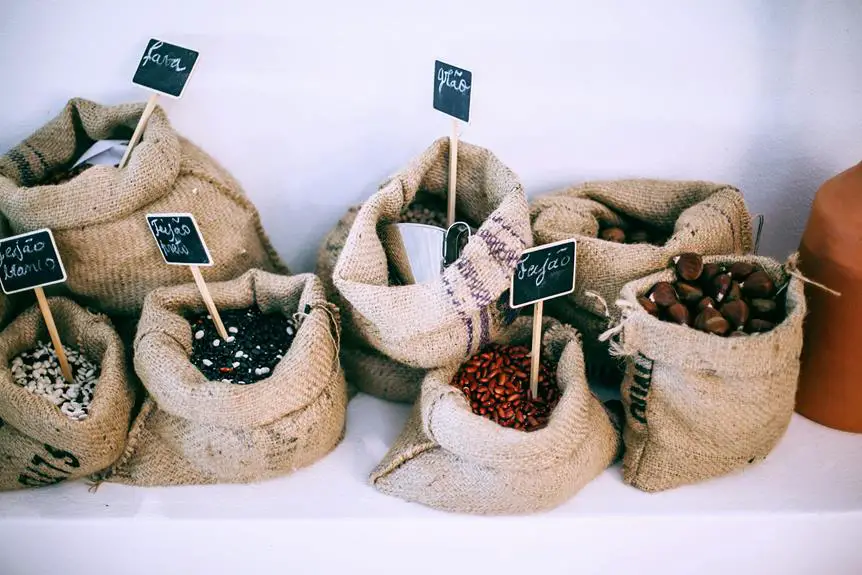When you're considering fleece fabrics, it's essential to understand the differences between types like polar fleece and microfleece. Each has unique characteristics that cater to specific needs, whether you're layering for warmth during outdoor activities or seeking a lightweight option for comfort. You might be surprised by the versatility of high-loft fleece or the plush feel of Sherpa fleece. As you explore these options, think about how each type can enhance your wardrobe or home. So, what factors should influence your choice of fleece?
Table of Contents
Key Takeaways
- Fleece fabric is primarily made from polyester, offering warmth, comfort, and breathability in various applications.
- Polar fleece is known for its exceptional warmth, lightweight feel, and excellent insulation, making it ideal for outdoor activities.
- Microfleece provides a lightweight alternative, offering warmth without bulk and moisture-wicking properties for dryness during activities.
- Sherpa fleece features a plush texture mimicking sheepskin, offering exceptional warmth and comfort in clothing and home décor.
Overview of Fleece Fabric
Fleece fabric is a soft, versatile material made from synthetic fibers, primarily polyester, that provides warmth and comfort in various applications. You'll find fleece used in everything from cozy blankets to stylish jackets. Its lightweight nature makes it an excellent choice for layering, whether you're heading outdoors or lounging at home.
When you think about fleece, consider its remarkable insulation properties. It traps body heat while remaining breathable, which is perfect for chilly days. Plus, it dries quickly if it gets wet, making it ideal for outdoor activities like hiking or camping. You won't have to worry about feeling damp or cold.
Fleece's softness and flexibility also mean it comes in various types, each catering to specific needs. You might choose thicker options for outerwear or lighter versions for base layers.
The fabric's ease of care is another bonus. Most fleece items are machine washable and resistant to wrinkling, which saves you time and effort.
Polar Fleece Characteristics
Polar fleece is known for its exceptional warmth and lightweight feel, making it a popular choice for outdoor gear and cozy apparel. This fabric is created from polyester, which gives it a soft, plush texture that's comfortable against the skin. You'll appreciate how polar fleece is breathable, ensuring that you stay warm without overheating during physical activities.
One of the standout characteristics of polar fleece is its excellent insulation properties. The fabric traps heat effectively, providing you with a snug barrier against cold weather. Additionally, it dries quickly, which is a huge advantage if you're caught in the rain or sweat during a hike.
Polar fleece is also highly durable, resisting wear and tear over time. You won't have to worry about pilling or losing shape after multiple washes. Plus, it's easy to care for—most polar fleece items are machine washable and maintain their vibrant colors.
Lastly, polar fleece comes in various weights and thicknesses, allowing you to choose the perfect option for your needs. Whether you're layering up for a winter hike or lounging at home, polar fleece has you covered.
Microfleece Benefits
Offering a lightweight alternative, microfleece provides exceptional warmth without the bulk, making it ideal for layering or everyday wear. This fabric is incredibly versatile and comes with a variety of benefits that you'll appreciate, whether you're heading outdoors or staying cozy at home.
Here are a few key advantages of microfleece:
- Breathability: Microfleece allows your skin to breathe, preventing overheating during physical activities while still providing insulation against the cold.
- Moisture-wicking: It effectively pulls moisture away from your body, keeping you dry and comfortable even during high-energy pursuits.
With its softness and lightweight feel, microfleece is perfect for anyone looking for comfort without sacrificing warmth. It's easy to care for, retains its shape, and resists pilling, making it a smart addition to your wardrobe.
Whether you're hiking, lounging at home, or running errands, microfleece has you covered.
High-Loft Fleece Features
How does high-loft fleece stand out in the realm of insulating fabrics?
This fabric boasts a unique structure that enhances warmth without adding excessive weight. Its lofty texture traps air effectively, providing excellent insulation while remaining lightweight. You'll appreciate how it feels soft against your skin, making it a cozy option for layering in colder weather.
High-loft fleece is also breathable, allowing moisture to escape, so you don't feel clammy when you're active. This feature keeps you comfortable whether you're out for a hike or just lounging at home. Plus, it's versatile—available in various thicknesses and styles, which means you can find the perfect fit for your needs.
Moreover, high-loft fleece is durable and resistant to wear, ensuring it'll last through many adventures. Its quick-drying properties mean you won't have to worry about staying damp for long if you get caught in the rain.
Sherpa Fleece Applications
When you think about Sherpa fleece, you can't help but appreciate its warmth and insulation benefits.
This cozy fabric is perfect for clothing and apparel, whether you're looking for a stylish jacket or a comfy blanket.
Plus, its versatility makes it a great choice for home décor, adding both comfort and charm to your space.
Warmth and Insulation Benefits
Sherpa fleece provides exceptional warmth and insulation, making it ideal for cozy blankets, jackets, and outdoor gear. Its plush texture mimics sheepskin, creating a soft barrier against the cold. When you wrap yourself in Sherpa fleece, you'll immediately feel the difference it can make on chilly days. This fabric traps heat effectively, ensuring you stay toasty whether you're lounging at home or adventuring outdoors.
Here are a few key benefits of Sherpa fleece regarding warmth and insulation:
- Heat Retention: The thick pile of Sherpa fleece retains warmth by creating small air pockets, preventing heat from escaping.
- Moisture Wicking: This fabric helps wick away moisture, keeping you dry and comfortable, which is essential for maintaining warmth.
Choosing Sherpa fleece for your blankets or outdoor gear ensures you'll enjoy warmth without sacrificing comfort or mobility. So, whether you're snuggling up indoors or braving the elements, you can count on Sherpa fleece to keep you cozy.
Clothing and Apparel Uses
The remarkable warmth and insulation of Sherpa fleece make it a popular choice for various clothing and apparel items, from cozy hoodies to stylish jackets. You'll find that its soft texture not only provides comfort but also adds a fashionable flair to your wardrobe.
Sherpa fleece is ideal for layering, making it a great option for outdoor activities or simply lounging at home. It's often used in pullovers, vests, and blankets, ensuring you stay warm without sacrificing style. Additionally, many brands use Sherpa fleece in accessories like hats and gloves, further enhancing your winter ensemble.
Here's a quick overview of some popular Sherpa fleece applications:
| Application | Description |
|---|---|
| Hoodies | Cozy and stylish, perfect for layering. |
| Jackets | Insulated and trendy for cold weather. |
| Pullovers | Soft and comfortable for everyday wear. |
| Accessories | Includes hats, gloves, and scarves. |
With its versatility and comfort, you can't go wrong with incorporating Sherpa fleece into your clothing collection. Embrace its warmth and style, and you'll be ready for any chilly adventure!
Home Décor Versatility
Transforming your living space with Sherpa fleece adds warmth and texture, creating a cozy atmosphere that invites relaxation and comfort. This versatile fabric is perfect for various applications, enhancing both style and functionality in your home.
You can easily incorporate Sherpa fleece into your decor through:
- Throw blankets: Drape them over couches or beds for an inviting touch.
- Cushions and pillows: Add plush Sherpa covers to your existing cushions for an extra layer of softness.
Sherpa fleece's ability to complement a multitude of design styles—from rustic to modern—makes it a fantastic choice for any room.
Whether you're looking to refresh your living room or cozy up your bedroom, this fabric provides not just comfort but also a stylish accent.
Plus, it's easy to maintain, ensuring your space stays inviting without much effort.
Choosing the Right Fleece
When you're choosing the right fleece, consider the fabric weight that suits your needs.
Think about what you'll be using it for and how you'll care for it to ensure it lasts.
These factors will help you make the best choice for your project.
Fabric Weight Considerations
Choosing the right fleece fabric involves understanding its weight, as this directly impacts warmth, breathability, and intended use. Fabric weight is typically measured in grams per square meter (GSM), and knowing this can help you select the perfect fleece for your needs.
When considering fleece weight, keep these factors in mind:
- Lightweight Fleece (100-200 GSM): Great for layering or mild weather. It offers breathability, making it ideal for active pursuits.
- Midweight Fleece (200-300 GSM): Balances warmth and breathability, perfect for everyday wear or cool evenings. It's versatile and suits various activities.
Intended Use Scenarios
Understanding the intended use of fleece fabric helps you select the right type for your specific activities and comfort needs.
If you're planning to engage in outdoor activities like hiking or skiing, polar fleece is an excellent choice. It's thick, warm, and provides great insulation against cold weather, keeping you cozy during your adventures.
On the other hand, if you need something lighter for casual wear or layering, microfleece is a fantastic option. It's soft, breathable, and dries quickly, making it ideal for workouts or everyday use.
When you're looking for something versatile, consider a mid-weight fleece. It strikes a balance between warmth and breathability, perfect for transitional seasons.
For lounging at home or snuggling on the couch, you might opt for cuddly fleece blankets or throws made from plush fleece. These fabrics offer an extra layer of comfort and warmth without being too restrictive.
Ultimately, consider the climate, your activity level, and how much warmth you'll need. Choosing the right fleece type ensures you stay comfortable and enjoy your activities to the fullest.
Care and Maintenance Tips
To keep your fleece looking great and lasting long, follow a few simple care and maintenance tips tailored to the specific type of fleece you choose. Understanding how to care for polar fleece, microfleece, or other variations is essential for maintaining their quality and performance.
First, always check the care label for specific washing instructions. In general, you'll want to wash fleece in cold water to prevent shrinking and fading.
Here are a few key tips:
- Avoid Fabric Softeners: They can break down the fibers and reduce the fleece's insulating properties.
- Air Dry When Possible: Tumble drying can cause pilling, so let your fleece air dry to maintain its texture.
Frequently Asked Questions
Can Fleece Fabric Be Recycled or Composted?
Yes, fleece fabric can be recycled, but it's not compostable due to its synthetic fibers. Check local recycling guidelines to see if they accept fleece, and always consider alternatives to reduce waste.
How Do I Care for Fleece Garments?
To care for fleece garments, wash them in cold water on a gentle cycle, avoid fabric softeners, and tumble dry on low heat. This keeps them soft, prevents pilling, and maintains their warmth and durability.
Is Fleece Fabric Suitable for Sensitive Skin?
Fleece fabric can be suitable for sensitive skin, but it depends on the specific type. You should look for hypoallergenic fleece options and test for irritation to ensure comfort while wearing it.
What Are the Environmental Impacts of Fleece Production?
Fleece production impacts the environment through water consumption, chemical usage, and microplastic pollution. You should consider these factors when choosing fleece products, as their lifecycle affects ecosystems and contributes to overall environmental degradation.
Can Fleece Be Used for Outdoor Gear?
Absolutely, you can use fleece for outdoor gear! Its lightweight, insulating properties keep you warm while remaining breathable. Just make sure you choose the right type for your specific outdoor activities and weather conditions.
- Tetron Fabric for Marine Applications: Durability and Use Cases - June 18, 2025
- Tetron Fabric for Outdoor Furniture: Weather Resistance and Care - June 18, 2025
- Tetron Fabric for Wall Coverings: Style and Application Tips - June 18, 2025







